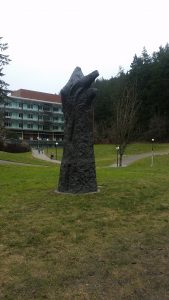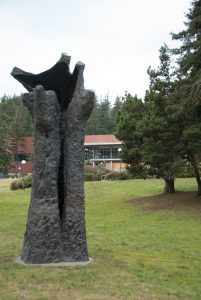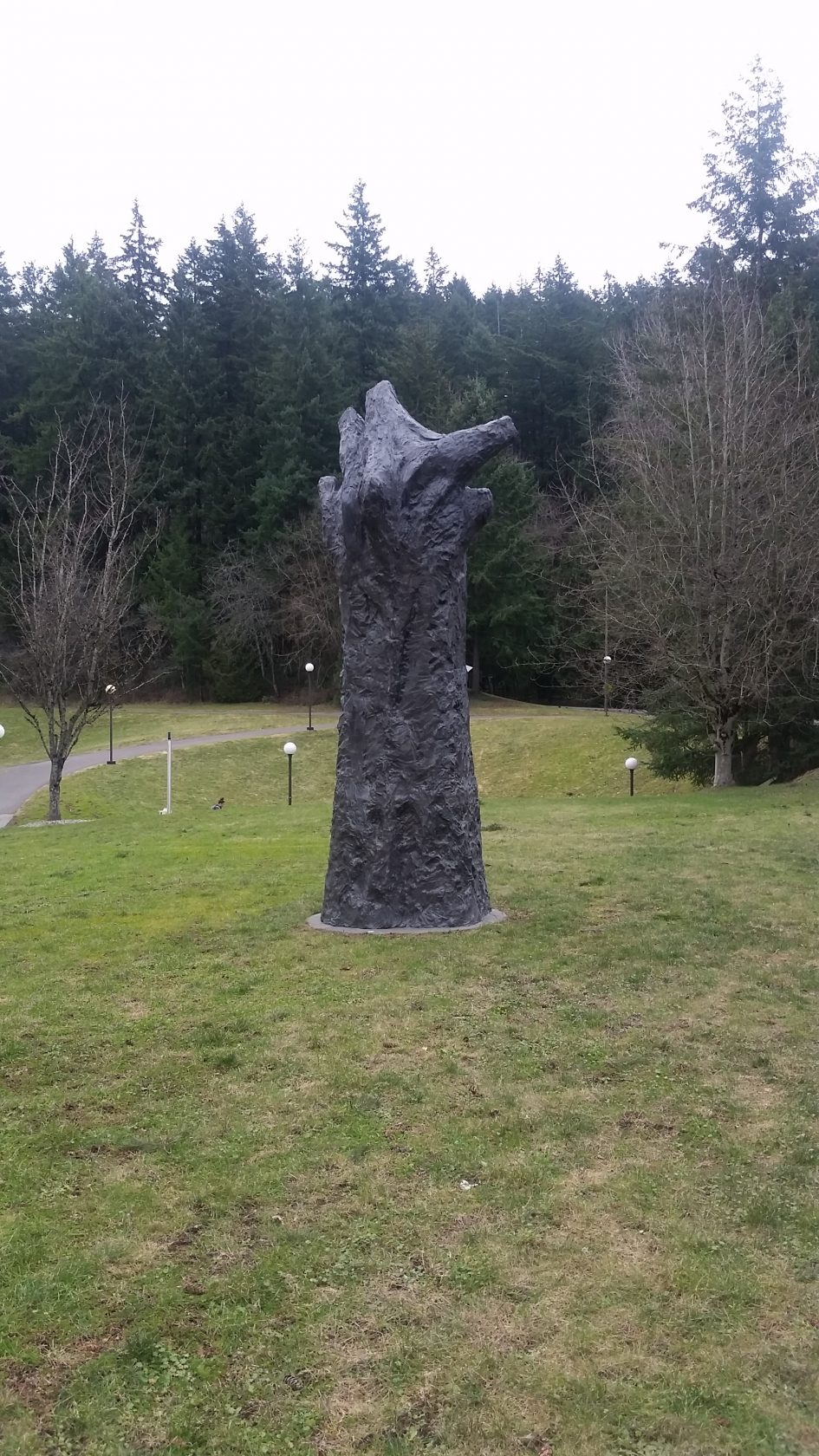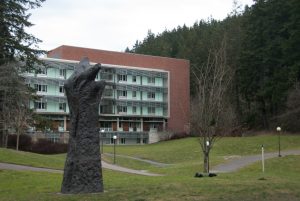Manus, a large tree-like sculpture located on the southern part of Western Washington University’s campus is part of Magdalena Abakanowicz’s Hand-Like Trees series. This sculpture created in 1994, is bronze and bee’s-wax and stands at 15’, the trunk itself is hollow and there is a thin vertical opening on one side.
ma·nus
ˈmānəs,ˈmänəs/
noun
ZOOLOGY
- The terminal segment of a forelimb, corresponding to the hand and wrist in humans.
“Manus” intends to show the viewer the human connection with nature, showcasing the melding of both flora and fauna. This name along with the shape of the sculpture (a tree-like-hand as it is referred to) gives more evidence to the motif of juxtaposition and interconnectedness of the natural world with the unnatural that the artist wishes to translate through this sculpture. The melded form of a hand/animal forearm and tree creates a towering and metaphoric figure that demands notice, simultaneously foreboding and welcoming.
The location is also important to consider; Abakanowicz chose this particular spot on WWU’s campus in order to connect with both the natural aspects of the nearby forest and the activities of students.

Situated at the south end of campus the location showcases the juxtaposition of the human world and natural forest.
(based on a sculpture by Magdalena Abakanowicz)
Always reaching
Never still.
Always hoping
Never in despair.
Always soothing
Never hurting.
Always renewing
Never withdrawing.
Always nourishing
Never starving.
Always working
Never resting.
Those who reach
Will accomplish.
Those who hope
Will succeed.
Those who comfort
Will be comforted.
But those who inflict pain
Will be haunted —-
Ghosts of their past
Will never let go.
-by UMA
This poem inspired by Magdalena’s work is actually based off the Hand Like Tree: Cecyna. There are multiple of these tree like sculptures created by Abakanowicz, which ties into her interest in the crowd.
“I feel overwhelmed by quantity where counting no longer makes sense. By unrepeatability within such quantity. A crowd of people or birds, insect or leaves, is a mysterious assemblage of variants of a certain prototype, a riddle of nature abhorrent to exact repetition or inability to produce it, just as a human hand can not repeat its own gesture”.
-Magdalena Abakanowicz
Magdalena Abakanowicz was born in Poland in 1930 and studied at the Academy of Fine Arts in Warsaw. Abakanowicz has created a variety of works ranging from large scale sculptures to drawings and paintings. Her work often showcases her fascination with nature and its relationship to our society. The occupation and political turmoil in Poland caused by the Soviet Union was a major influence on Magdalena’s work and who she became as an artist. “Her art has always addressed the problems of dignity and courage. This dignity resistance and will of survival conceal her individual personal affinities to the culture of Poland, the country where she has grown up, to this country”s political situation, and to the realities of existence of an artist, an intellectual.” Her sculptures have an unique sense; simultaneously organic and inorganic. The works often have an ambiguous meaning, Abakanowicz “prefers to leave the meaning of her art up to the psyche of each viewer, and never explains her art”. Not only is she a highly praised and noted artist, Magdalena also worked as a professor at the Academy of Fine Art in Poland from 1965-1990 and was a visiting professor at UCLA in 1984. She has also received many awards throughout her lifetime from multiple countries for being such a creative visionary. Abakanowicz has received honorary doctorates from many institutions including, Royal College of Art in London, the Rhode Island School of Design, Academy of Fine Arts in Lodz, Poland, Pratt Institute, the Massachusetts College of Art, the School of the Art Institute of Chicago, and the Academy of Fine Arts in Poznan, Poland.
Manus was sculpted in 1994. Immediately prior to making this piece, she had been working on a series titled War Games which consisted of huge tree trunks, with their branches and bark removed, decorated with rags and steel hoops. This certainly influenced her Hand-like Trees series.

Some of the other works she is known for are Abakans and Humanoid Sculptures. In 1967 Abakanowicz started creating large, three-dimensional fibre works called Abakans. They were often woven from ropes found on harbors. These works had a significant influence on all of the work she has created since. In the 70’s and 80’s she started making humanoid sculptures made out of pieces of coarse sackcloth which she sewed and pieced together and bonded with synthetic resins. Many of the works she is most known for include Alterations, Heads, Backs and The Crowd I, all examples of humanoid sculptures.
As with much of her work, the interpretation of Manus is left to the viewer as Magdalena Abakonowicz intends…
“Abakanowicz, creates ambiguous images with many meanings. Some are concealed, some combined with others. These are what every viewer must find for him or herself. To reveal them all would be to tell the reader how a film ends.”
Sources/Credit:
Photos: Rio Edwards and Celeste Alexander
Biography http://www.abakanowicz.art.pl/about/biography.php.html. Accessed 12 Feb. 2017
Poem: Hand-Like-Tree https://groundsforsculpture.wordpress.com/2010/02/12/poem-hand-like-tree/. Accessed 13 Feb. 2017
Recent works. http://www.abakanowicz.art.pl/recent/-recent.php.html. Accessed 8 Feb. 2017






Leave a Reply